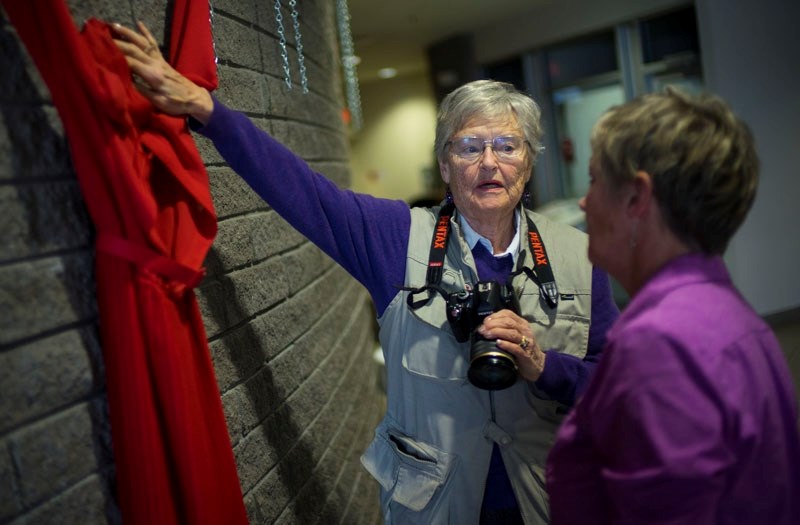An RCMP report last year determined that there were 1,181 missing and murdered aboriginal women across Canada in the years from 1980 to 2012. The federal government’s recently announced an inquiry that would finally examine this long-overlooked tragedy, yet there’s a group of artists and socially concerned citizens that has been taking the cause to the streets in its own way for about a year now.
If you have driven through Edmonton since last January, perhaps you’ve noticed a red dress – the very symbol that has come to stand in the place of all of those women – posed on a hanger dangling from a tree branch or other public fixture. The Red Dress Photography Project is an effort by a small group of photographers across the country to place those dresses temporarily and gather 181 photos of these dresses for a travelling exhibit of art and social commentary.
Mufty Mathewson is a passionate photographer who has conducted other types of similar art projects over the last 35 years. She read in the news in January and saw an advertisement by Edmonton photographer Wen Kauffman. The ad showed a red dress in the forest with some descriptive text.
“It said, ‘Imagine if 1,181 of your daughters never returned home? Imagine no one cared.’ So there I was sitting in my jammies in the living room reading the paper and thinking, ‘You know what? I do care.’ How can an 81-year-old woman say, ‘What can I do?’”
She told herself that she could take pictures as a way of drawing further attention to the issue. It was only after she started that she discovered a similar – and still ongoing – effort called the REDress Project, started by Métis artist Jaime Black from Winnipeg. Kauffman was the first to take a photo of some dresses placed along Saskatchewan Drive by the University of Alberta. Those can be found on her blog on her website at www.wenkauffmanphotography.com.
Mathewson saw the image and wanted to do her part too.
“I thought that I had to do it because it was really compelling for me at that point.”
She bought some red dresses and placed them around Edmonton for her photography. It was only after she teamed up with a young aboriginal woman artist to take pictures of a dress blowing in the breeze along a railroad track in Stony Plain that she thought of her membership in Images Alberta, a group of Edmonton area photographers who share their expertise in order to further their artistic development. She thought that some of those people might wish to join her.
“The day I did that was a cold winter day, and eight photographers came to my house. Between all of us, we hung dresses all up and down the street. It just started. It caught on.”
The project has continued and has grown since then. Mathewson noted that dresses have even travelled to Nunavut for temporary installation and photos there. Some of her cohorts here have travelled across Canada to continue in other provinces too. One such trip had a stop at Parliament Hill.
Last weekend, they were at La CitĂ© Francophone with more red dresses, taking more photographs. An exhibit of the photos was at Edmonton Public Schools’ Education Centre until Thursday. It was accompanied by a drummer and a singer with a prayer song to remember the 1,181 women and to call for justice. An exhibit is scheduled at La CitĂ© for January 2016.
The Red Dress Project will continue on through next year and possibly beyond.
“It’s one of those things. How could I stop?” she said, offering some praise in light of the announcement of the inquiry. “We want people to pay attention to the issue and get serious about it.”
Mathewson suggested that anyone who goes out this weekend could try looking at the bottom of Bellamy Hill in Edmonton to see one for themselves. A Facebook group has also been started by the participants to organize new installations. She said that anybody could join in the project by taking a photo of their own red dress.
“It’s just one of those things that raises awareness and honours those many, many, many women who have not been honoured before.”




